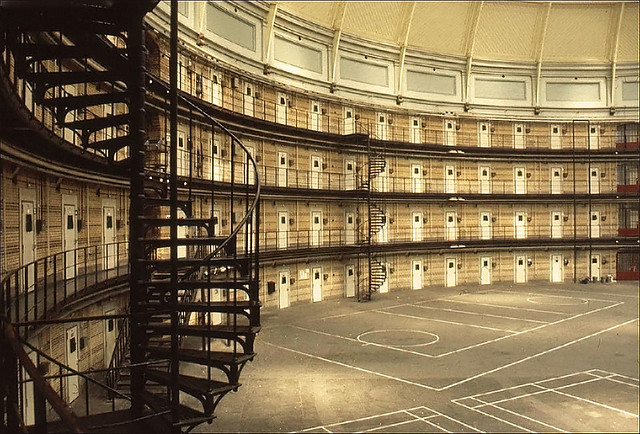
Panopticism is a
theory that originates from studying the behavioural activity and effects of
confining the criminal and the insane in the 1600’s. The Great Confinement was
instigated to create a purer and more productive society, this brought about
the birth of the asylum where prisoners were rewarded for good behaviour and
punished for bad behaviour. To perfect the efficiency of this method of
rehabilitation the Panopticon was built in 1791, unlike previous prisons and
dungeons which hide prisoners beneath the surface of society and treat them as
a group the Panopticon put a spotlight on the patient and built in them a
feeling of being constantly watched and monitored.
It achieved this by
containing prisoners in a circular building in which the cells are built around
the circumference and facing inwards towards a viewing tower. The guards in the
central viewing tower have 360º of vision of all the prisoners whereas the
prisoners view of the guards is obscured by blinds. This relationship of
watching / being watched produces strong control over the prisoners, as they
are constantly on show and being monitored their behaviour improves because
misbehaving is counterproductive.
Foucalt calls this
Panopticism, which he writes about in his book Discipline and Punish. He describes the architectural design of the
Panopticon as, "They are like so many small cages, so many
small theatres, in which each actor is alone, perfectly individualised and
constantly visible."
This visibility removes the need of a physical presence
in the central tower as this is processed internally by the prisoner, "The major effect of the Panopticon: to
induce in the inmate a state of conscious and permanent visibility that assures
the automatic functioning of power."
This one sided gaze
relationship is present in a lot of modern day systems, most notably CCTV in
shops and supermarkets. Here there is an obvious and constant reminder of being
watched without ever seeing any evidence of somebody watching you. This is
reinforced by Foucalts idea that:"Power
should be visible and unidentifiable", which is exactly
the relationship that CCTV has with the customer, this unidentifiable power
could range from a fake camera to a security centre that is being monitored by
the head of Police.
Foucalt writes about the subject, "He is seen but he does not see; he is
the object of information, never a subject in communication."
This conscious feeling of being monitored and
watched is so strong within the public that the recent addition of self
checkouts in supermarket has become possible. Here the customers are trusted to
scan and pay for their own items without supervision, this works by having the
machines in an open area with no enclosure, usually in the busiest part of the
supermarket where everyone is paying for goods, similar to the layout of the
Panopticon, Foucalt explains this change in behaviour because “Visibility is a trap.”.
Overall, Foucalt’s method of
referencing the Panopticon to explain social control is saying that power is
not a thing that anyone can have or own: “it is a relation between individuals, where there is power, there
is resistance."

No comments:
Post a Comment